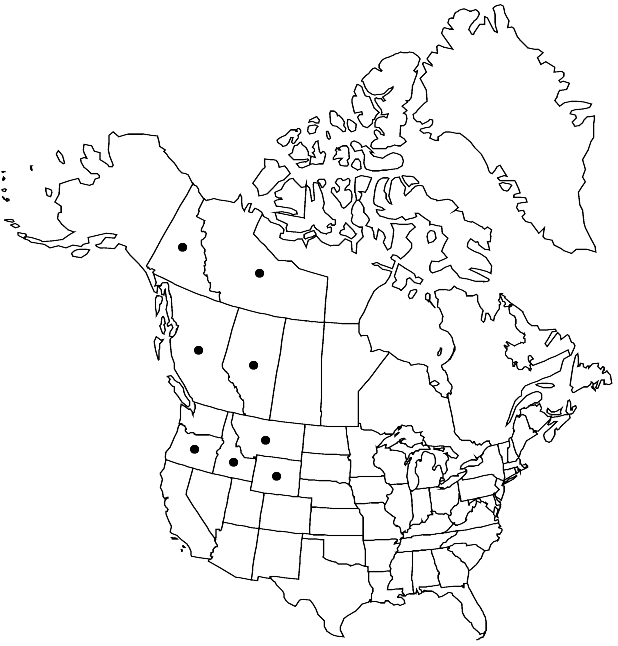Salix farriae
Contr. U.S. Natl. Herb. 22: 321. 1921.
Plants 0.2–1.5(–2) m. Stems: branches red-brown, not glaucous to strongly glaucous on buds, glabrous or puberulent at nodes; branchlets yellow-brown or red-brown, (sometimes weakly glaucous), glabrous or puberulent, (inner membranaceous bud-scale layer free, separating from outer layer). Leaves: stipules absent, rudimentary or foliaceous on early ones, foliaceous on late ones, apex acute; petiole shallowly grooved, or convex to flat adaxially, 5–8 mm, puberulent adaxially; largest medial blade narrowly elliptic or elliptic, (20–)30–65(–75) × (8–)10–30(–35) mm, 1.8–3.7 times as long as wide, base convex, rounded, or cuneate, margins slightly revolute or flat, entire or shallowly serrulate, apex acute, acuminate, or convex, abaxial surface glaucous, glabrous or glabrescent, adaxial slightly glossy or dull, glabrous or pilose, midrib sparsely pubescent, hairs short, white, and ferruginous; proximal blade margins entire or serrulate; juvenile blade green, glabrous, or midrib sparsely villous abaxially, hairs usually white and ferruginous. Catkins flowering as leaves emerge; staminate stout, 11–25 × 6–11 mm, flowering branchlet 1–5 mm; pistillate densely or loosely flowered, stout, 14–38.5 × 8–14 mm, flowering branchlet 1.5–14 mm; floral bract brown, black, or bicolor, 0.7–2 mm, apex rounded to convex, abaxially hairy, hairs wavy. Staminate flowers: adaxial nectary oblong, square, or ovate, 0.2–0.9 mm; filaments distinct, glabrous; anthers yellow, 0.3–0.6 mm. Pistillate flowers: adaxial nectary oblong or ovate, 0.4–0.8 mm, shorter than stipe; stipe 0.5–1.2 mm; ovary pyriform, glabrous, beak gradually tapering to styles; ovules 12–19 per ovary; styles 0.3–1.2 mm; stigmas flat, abaxially non-papillate with rounded tip, or 2 plump lobes, 0.2–0.3–0.56 mm. Capsules 3–7 mm.
Phenology: Flowering late May-late Jul.
Habitat: Wet montane to subalpine meadows, stream banks
Elevation: 600-2700 m
Distribution

Alta., B.C., N.W.T., Yukon, Idaho, Mont., Oreg., Wyo.
Discussion
Salix farriae is a cordilleran species ranging from Wyoming to central British Columbia with disjunct occurrences in northwestern British Columbia, western Northwest Territories, and southern Yukon. It is related to S. hastata, an amphiberingian species ranging from Scandinavia to southwestern Yukon and northwestern Northwest Territories. There may be reasons for treating these slightly different plants as S. hastata var. farriae, but R. D. Dorn (1975) maintained them as a species based on flavonoid differences. In a phenetic study (G. W. Argus 2007), the two taxa had dissimilarity values at the same level as other closely related species. They are treated here as species, primarily because their ranges are disjunct. They can be separated as follows:
Salix farriae is distinguished from S. hastata by having largest medial blades narrowly elliptic to elliptic, pistillate nectaries oblong or ovate, stipules on early leaves absent or rudimentary (sometimes foliaceous), branches strongly to weakly glaucous or not, floral bract apices rounded, and plants of the cordillera in Alberta and British Columbia, in Idaho, Montana, Oregon, and Wyoming; S. hastata has largest medial blades narrowly elliptic to broadly elliptic or broadly obovate, pistillate nectaries square, stipules on early leaves foliaceous (sometimes rudimentary), branches not glaucous, floral bract apices acute or rounded, and plants of Alaska, Northwest Territories, and Yukon.
Salix farriae and S. barclayi are sympatric in western Canada and the Pacific Northwest, where they are difficult to separate. Salix farriae can often be recognized by its largest medial leaves with at least some minute, ferruginous hairs on the adaxial midrib or blade surfaces; ferruginous hairs do not occur in S. barclayi. Its leaf margins also tend to be more nearly entire, but relatively short teeth are not infrequent. Such plants are sometimes interpreted as intergrades between S. farriae and S. barclayi (R. D. Dorn 1975). The variable leaf toothing also occurs in S. hastata and may not be a reliable indicator of intergradation. Salix farriae also differs from S. barclayi in usually having shorter anthers, 0.3–0.6 mm versus 0.6–1 mm in S. barclayi. See 61. S. barclayi.
Hybrids:
Salix farriae forms natural hybrids with S. barclayi.
Selected References
None.